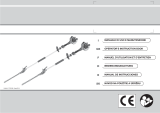
4. WHAT YOU NEED TO KNOW
The engine performance, reliability and life are
influenced by many factors, some external and
some strictly associated with the quality of the
products used and with the scheduled mainte-
nance.
The following information allow a better under-
standing and use of your engine.
4.1
ENVIRONMENTAL CONDITIONS
The operation of a four-stroke endothermic
engine is affected by:
a) Temperature:
– Working in low temperatures could lead to a
difficult cold starting.
– When operating at very high temperatures, a
warm start could prove difficult due to evapora-
tion of fuel in the float chamber of the carburet-
tor or in the pump.
– In any case, the right kind of oil must be used,
according to the operating temperatures.
b) Altitude:
– The higher the altitude (above sea level), the
lower the max power developed by an endo-
thermic engine.
– When there is a considerable increase in
altitude, the load on the machine should be
reduced and particularly heavy work avoided.
4.2
FUEL
A good quality fuel is the major issue for the
engine reliability of operation.
Fuel must meet these requirements:
a) Use clean, fresh unleaded gasoline, with a
minimum of 90 octane.
b) Do not use fuel formulated with ethanol greater
than 10%.
c) Do not add oil.
d) To protect the fuel system from gum formation,
mix a fuel stabilizer into the fuel.
Use of unapproved fuels will cause damage to
engine components, which will not be covered
under warranty.
4.3
OIL
Use always high quality oils, choosing their vis-
cosity grade according to the operating tempera-
ture.
a) Only use SF-SG quality classified detergent
oil.
b) Choose the SAE viscosity grade of oil from this
chart:
– from 5 to 35 °C = SAE 30
–
from -15 to + 35 °C =
10W-30
(Multi-viscosity)
c) The use of multi-viscosity oils in hot tem-
peratures will result in higher than normal oil
consumption; therefore, check oil level more
frequently.
d) Do not mix oils of different brands and fea-
tures.
e) SAE 30 oil, if used below +5°C, could result
in possible engine damage due to inadequate
lubrication.
f)
Oil should be at «MAX» mark (see 5.1.1): do
not overfill. Overfilling with oil may cause:
– Smoking;
– Spark plug or air filter fouling, which will
cause hard starting.
4.4
AIR FILTER
The air filter must always be in perfect working
order, to prevent debris and dust from getting
sucked into the engine, reducing the efficiency
and life of the machine.
a) Always keep the filtering element free of debris
and in perfect working order (see 6.5).
b) If necessary, replace the filtering element with
an original spare part. Incompatible filtering
elements can impair the efficiency and life of
the engine.
c) Never start the engine without mounting the
filtering element properly.
4.5
SPARK PLUG
Not all the spark plugs for endothermic engines
are the same!
a) Use only spark plugs of the recommended
type, with the right heat range.
b) Check the length of the thread, because – if
too long – it will damage the engine beyond
repair.
c) Make sure that the electrodes are clean and
their gap is correct (see 6.6).
3
EN













